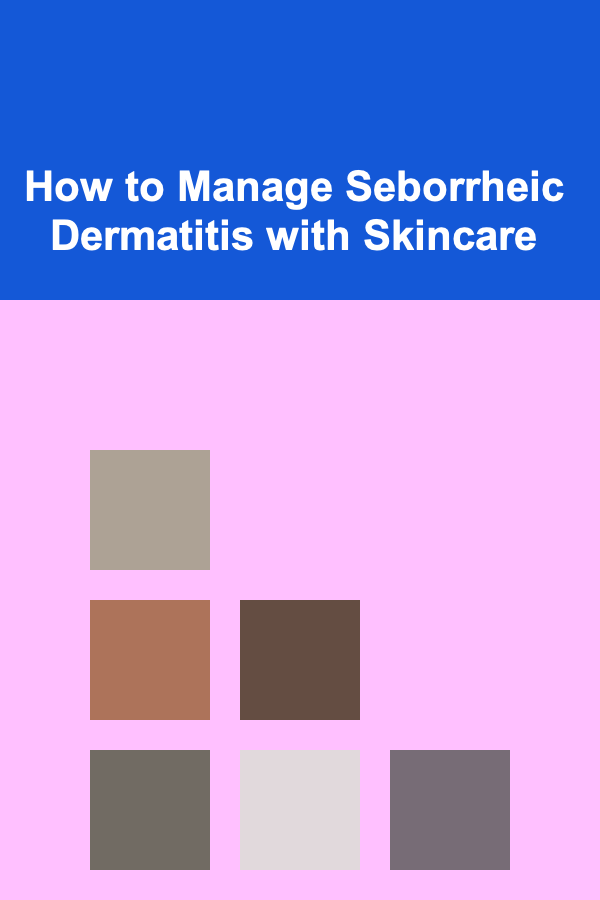
How to Manage Seborrheic Dermatitis with Skincare
ebook include PDF & Audio bundle (Micro Guide)
$12.99$7.99
Limited Time Offer! Order within the next:

Seborrheic dermatitis is a common yet chronic condition that causes red, inflamed, and flaky skin, often on the scalp, face, and other oily areas of the body. It is a condition that can significantly affect a person's self-esteem, and it often requires long-term management strategies to keep flare-ups under control. While the cause of seborrheic dermatitis is not entirely understood, factors such as yeast overgrowth, skin oil production, and genetic predisposition play a role in its development.
In this article, we will explore effective skincare strategies to manage seborrheic dermatitis, including treatment options, lifestyle changes, and practical tips to help you achieve and maintain clear, healthy skin.
Understanding Seborrheic Dermatitis
Seborrheic dermatitis is a chronic skin condition that primarily affects areas with a high density of sebaceous (oil-producing) glands. This includes the scalp, face, chest, and back. Symptoms can range from mild irritation and dandruff to severe redness, itching, and scaling. Although it's a long-term condition, seborrheic dermatitis can usually be managed with proper skincare.
Causes and Risk Factors
The exact cause of seborrheic dermatitis remains unclear, but several factors contribute to its development:
- Malassezia Yeast: This yeast, which naturally exists on the skin, can proliferate in oily areas and cause inflammation, leading to the characteristic scaling of seborrheic dermatitis.
- Skin Oils: Overproduction of sebum or oil by sebaceous glands creates a favorable environment for yeast growth, which in turn triggers skin irritation.
- Genetic Factors: A family history of seborrheic dermatitis or other skin conditions such as psoriasis can increase susceptibility.
- Hormonal Changes: Hormonal fluctuations, such as during puberty or pregnancy, can exacerbate the condition.
- Environmental Factors: Cold weather, dry air, and stress are known to trigger flare-ups.
Symptoms
Common symptoms of seborrheic dermatitis include:
- Red, inflamed skin
- Flaky, greasy scales
- White or yellowish flakes, especially on the scalp
- Itchy or irritated skin
- Scalp dandruff
- Crusty patches, particularly in babies (cradle cap)
Although seborrheic dermatitis can be uncomfortable, it is not contagious and can usually be controlled with proper care and treatment.
Key Skincare Strategies for Managing Seborrheic Dermatitis
Managing seborrheic dermatitis requires a comprehensive approach that focuses on balancing oil production, controlling inflammation, and reducing yeast overgrowth. Below are some skincare tips and treatments to help keep the condition under control.
1. Cleansing with Gentle, Non-Irritating Products
Proper cleansing is an essential part of managing seborrheic dermatitis. The right cleanser can help remove excess oil, scales, and dead skin cells without aggravating the condition. It is important to avoid harsh soaps or cleansers that strip the skin of its natural oils, as this can cause further irritation.
Recommended Cleansers:
- Fragrance-free or hypoallergenic products: Choose cleansers that are free of harsh chemicals, fragrances, and artificial colors. These ingredients can irritate sensitive skin and worsen symptoms.
- Shampoos with antifungal properties: Since Malassezia yeast plays a significant role in seborrheic dermatitis, shampoos containing antifungal agents like ketoconazole, selenium sulfide, or zinc pyrithione can be highly beneficial. These ingredients help reduce yeast proliferation and control inflammation.
Tip: Wash your face and scalp regularly (once or twice a day), but avoid overwashing, as excessive cleansing can lead to dryness and irritation.
2. Exfoliating to Remove Dead Skin Cells
Exfoliating the skin can help remove the buildup of dead skin cells and flakes associated with seborrheic dermatitis. However, it's essential to use gentle exfoliants that won't cause further irritation.
Types of Exfoliants:
- Physical exfoliants: Mild scrubs with fine granules can be used gently on affected areas, but they should not be abrasive or harsh.
- Chemical exfoliants: Products with salicylic acid or glycolic acid can help break down the buildup of skin cells, promoting smoother skin. However, these should be used sparingly to avoid irritation.
Tip: Limit exfoliation to 1-2 times per week to prevent stripping the skin's natural barrier.
3. Moisturizing with Non-Comedogenic Creams
Seborrheic dermatitis often affects oily areas of the skin, yet moisturizing is still crucial to keeping the skin hydrated and preventing dryness. The key is choosing moisturizers that are suitable for sensitive and oily skin.
Recommended Moisturizers:
- Oil-free, non-comedogenic creams: These products hydrate the skin without clogging pores or aggravating seborrheic dermatitis.
- Moisturizers with ceramides: Ceramides help restore the skin's natural barrier and prevent moisture loss, which is important for overall skin health.
Tip: Apply moisturizer immediately after cleansing while the skin is still slightly damp to lock in moisture.
4. Topical Treatments for Seborrheic Dermatitis
In addition to daily skincare routines, topical treatments can be used to manage more severe flare-ups. These treatments help reduce inflammation, control yeast growth, and alleviate itching.
Antifungal Creams and Shampoos
- Ketoconazole: Available in both shampoo and cream formulations, ketoconazole is an antifungal agent that helps control Malassezia overgrowth and reduce inflammation. It is one of the most common treatments for seborrheic dermatitis on the scalp and face.
- Selenium sulfide: This antifungal shampoo helps to reduce dandruff and skin flakes while also treating seborrheic dermatitis.
Corticosteroid Creams
For inflamed and irritated patches, mild corticosteroid creams can be used to reduce inflammation and itching. However, these should be used sparingly and for short periods of time to avoid side effects like skin thinning.
Tip: Use antifungal treatments and corticosteroids as directed by a dermatologist, and avoid prolonged use of corticosteroids to prevent potential skin damage.
5. Sun Protection
While a small amount of sun exposure can help reduce symptoms of seborrheic dermatitis for some people, excessive sun exposure can exacerbate the condition and increase the risk of skin damage. Therefore, it's important to practice proper sun protection.
Sun Protection Tips:
- Use broad-spectrum sunscreen: Choose a sunscreen with SPF 30 or higher that provides protection against both UVA and UVB rays.
- Avoid peak sun hours: Try to stay out of the sun during peak hours (10 a.m. to 4 p.m.) to prevent excessive exposure.
6. Dietary Considerations
While there is no specific "seborrheic dermatitis diet," certain dietary choices may help improve skin health and reduce inflammation. Omega-3 fatty acids, antioxidants, and foods that reduce inflammation can play a role in managing the condition.
Helpful Foods:
- Fatty fish: Rich in omega-3 fatty acids, which have anti-inflammatory properties.
- Leafy greens: Full of antioxidants, which help combat oxidative stress and inflammation.
- Probiotics: Foods like yogurt, kefir, and fermented foods can help balance gut bacteria and may have a positive effect on skin health.
Tip: Try keeping a food journal to identify any foods that may trigger flare-ups or worsen symptoms.
7. Stress Management
Stress is known to be a significant trigger for seborrheic dermatitis flare-ups. Finding effective ways to manage stress can help prevent or minimize outbreaks. Regular physical activity, mindfulness, yoga, and relaxation techniques such as deep breathing can all help reduce stress levels.
Tip: Engage in stress-reducing activities like meditation or regular exercise to improve overall skin health.
8. When to See a Dermatologist
While many people can manage seborrheic dermatitis at home with skincare products and lifestyle changes, some cases may require professional intervention. If you experience persistent or severe symptoms, it's important to seek advice from a dermatologist. They may prescribe stronger treatments, such as oral antifungal medications or higher-strength topical steroids, to help manage the condition.
Conclusion
Seborrheic dermatitis is a chronic condition that requires ongoing management, but with the right skincare routine and treatment options, it is entirely possible to keep flare-ups under control. By using gentle cleansing products, moisturizing regularly, incorporating antifungal treatments, and making necessary lifestyle adjustments, you can significantly reduce the impact of seborrheic dermatitis on your daily life.
Remember that everyone's skin is unique, and what works for one person may not work for another. Be patient, experiment with different products, and consult with a dermatologist if needed. With the right care and attention, you can manage seborrheic dermatitis effectively and enjoy clear, healthy skin.

How to Balance Saving and Spending in Your Budget
Read More
How to Build a Checklist for Managing User-Generated Content on Social Media
Read More
How to Manage Debt While Sticking to Your Budget
Read More
How to Organize Your Small Kitchen Drawers
Read More
How To Monetize Your Travel Content
Read More
Choosing the Best Locations for Extreme Sports: A Comprehensive Guide
Read MoreOther Products

How to Balance Saving and Spending in Your Budget
Read More
How to Build a Checklist for Managing User-Generated Content on Social Media
Read More
How to Manage Debt While Sticking to Your Budget
Read More
How to Organize Your Small Kitchen Drawers
Read More
How To Monetize Your Travel Content
Read More